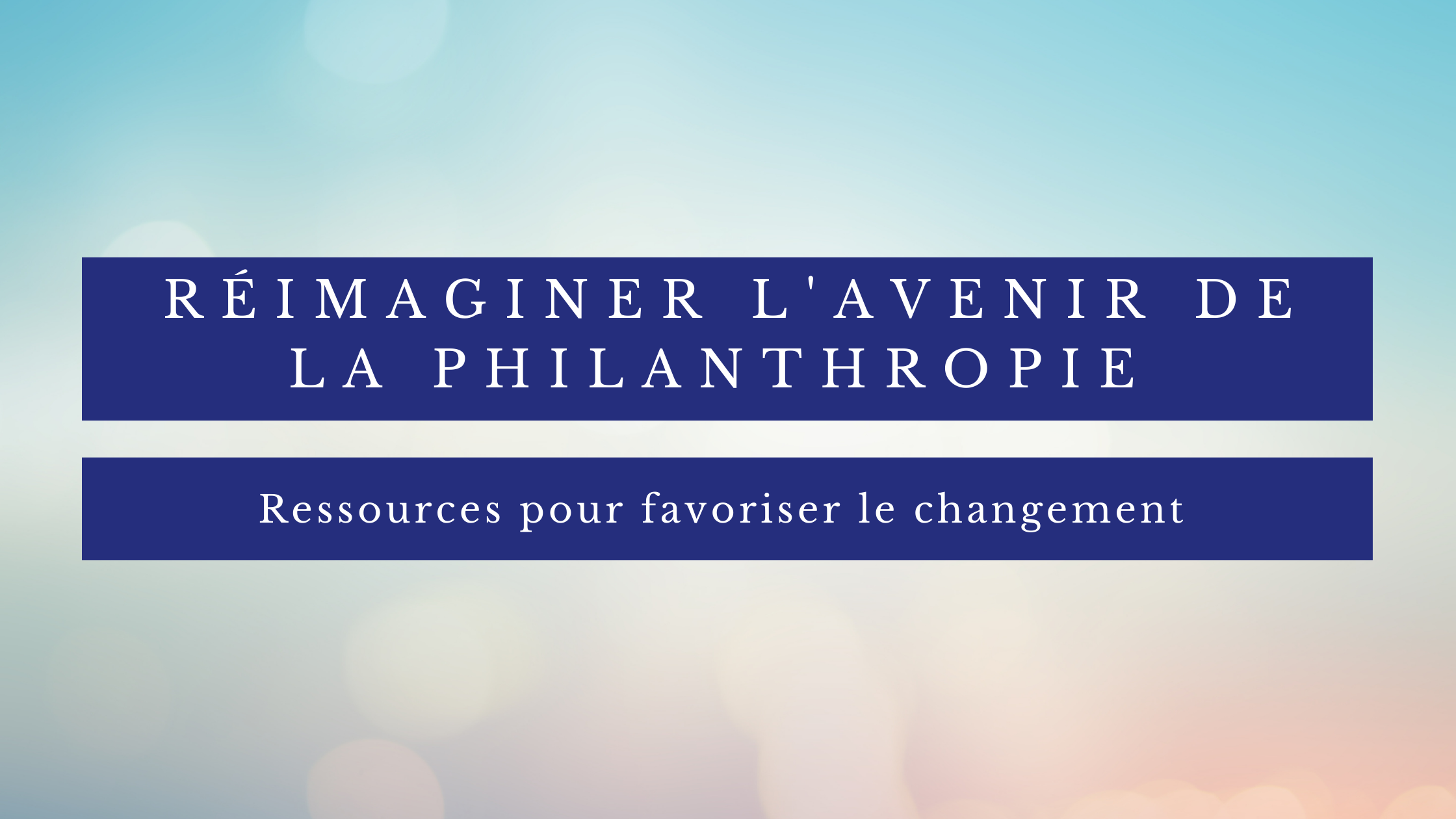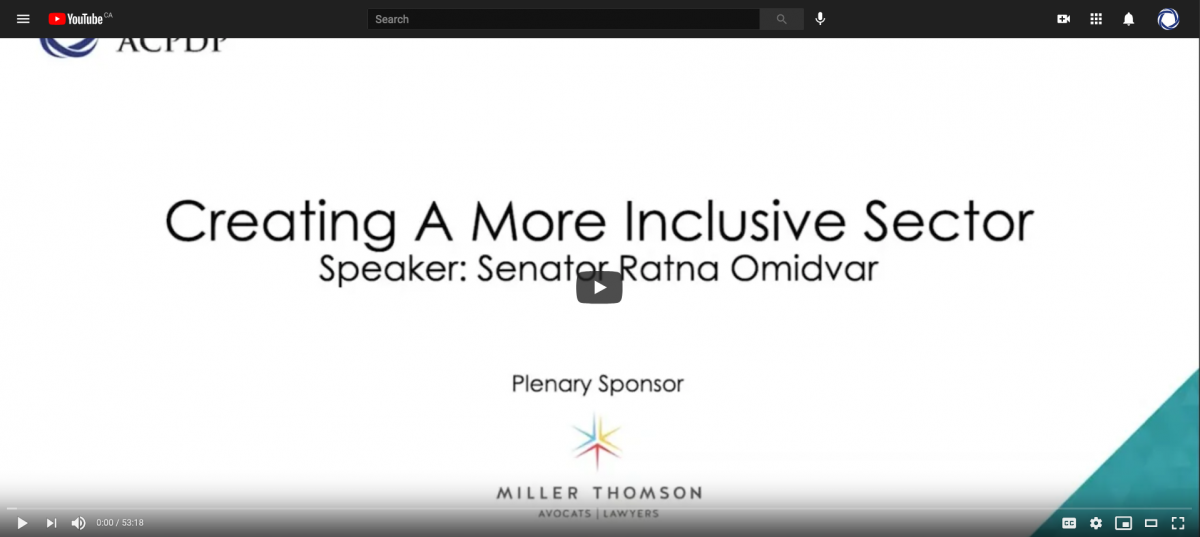
Langues
Réimaginer l'avenir de la philanthropie - Ressources pour favoriser le changement

Le 27e Congrès sur la philanthropie stratégique de l’ACPDP qui a eu lieu du 14 au 16 avril 2021 a abordé divers grands thèmes et réuni les participants autour de ce cri de ralliement : Réinventer l’avenir de la philanthropie. La sénatrice Ratna Omidvar a parlé jeudi matin de la création d'un secteur plus inclusif. Le message de la sénatrice a profondément touché les participants au congrès, à tel point qu’ils nous ont demandé de rendre ces informations publiques afin de pouvoir les partager avec leurs dirigeants et les membres de leur conseil.
http://bit.ly/CreatingInclusiveSector
La plénière de clôture du congrès a réuni trois leaders d'opinion qui ont parlé de la réinvention de l'avenir de la philanthropie. Les propos et les idées percutantes présentés par Andrew Chunilall, PDG de Fondations communautaires du Canada, Naki Osutei, vice-présidente associée, Impact social (Canada), du service Entreprise citoyenne mondiale de la Banque TD, et Natasha Smith, associée chez Miller Thompson LLP et membre de leur groupe d'impact social, ont transporté notre public au point qu'une fois de plus nous avons été submergés par les demandes de rendre ces présentations convaincantes accessibles au public. Nous sommes aujourd’hui heureux de le faire.
http://bit.ly/ReimaginingPhilanthropy
La sénatrice Ratna Omidvar a présenté cinq points d'action au cours de sa séance plénière et nous les a généreusement fournis par écrit afin de permettre à toute personne intéressée de reprendre ces idées et de les transformer en actions.
Five Good Ideas for Transforming into Warriors for Justice - By Senator Ratna Omidvar
Systemic racism tends to hide in unlikely places. At times it has clear victims, but at times it expresses itself in seemingly benign ways. Although they are not immediately obvious, deeply embedded expressions of colonialism can even be found in the Income Tax Act.
Let’s start with the legally recognized definition of philanthropy. According to Canadian law, charities can engage in relief of poverty, education, religion, and other general purposes. You would think that most organizations engaged in public good would fit in. You would be wrong.
As one example, let’s take relief of poverty. Our understanding of relief of poverty is grounded in the old-world construct of the rich giving to the poor to alleviate their suffering. And although organizations that relieve poverty, such as food banks, are deemed charitable, those that seek to prevent poverty, such as credit counselling services, are not. Many equity-seeking groups, whether they focus on racial or Indigenous justice, likely do not fit into these four types of activities. And even when they apply for status, and their application is rejected, they find no recourse in the courts. Not a single decision of the Canada Revenue Agency (CRA) has been overturned by the courts in the last 50 years.
I know that many of you will be thinking: what makes this an expression of systemic racism? For a very simple reason: it shuts the door on a new modernized definition of charity which takes racial injustice and inequity into account. It prevents organizations that focus on these issues from accessing charitably exempt donations. There is of course a solution – we can either legislate a modernized version of the definition or we can allow appeals of refused or deregistered organizations to proceed, not to the federal court, but to the Tax Court, which is less expensive and, most importantly, is able to call witnesses and subject matter experts.
The Income Tax Act also limits charities to spending their charitable dollars in two ways. First, charities can grant charitable dollars to another charity. Second, they can spend their charitable dollars to pursue their own charitable activities. So far so good, because these limits are in place to ensure that charitable dollars are spent on charitable activities. No one can argue with accountability.
But what happens when a charity is best served by working with a non charity, such as a not-for-profit, a co-op, a social enterprise, or a local organization? In this case, the CRA will demand that the charity be fully accountable for the partner organizations’ spending, as if these activities were their own. This is called, in CRA language, “direction and control”. The impact is severe. Since many indigenous and racial justice organizations are not charities, they are not able to receive donations. It is no wonder that less than 6% of charitable dollars flow to Indigenous organizations and even less to BIPOC organizations. The impact is even more severe for Canada’s international development charities who work with organizations thousands of miles away. Academics and lawyers have concluded that this law is racist and colonial and must be replaced. I have tabled a bill in the Senate to accomplish this. My bill, known as the Effective and Accountable Charities Act, will replace the current Income Tax Act language of “own activities” with new language of “resource accountability”, which will both empower charities while holding them accountable.
But legislation is only one part of the equation – we also need to think about the construct of philanthropy as we know it. What is the real purpose of philanthropy? Is it a vehicle to meet the interests of the donor or is it a vehicle to meet the needs of society? I believe that Darren Walker, CEO and President of the Ford Foundation, said it best in his recent interview with 60 Minutes when he made the point that philanthropy is not about generosity. His argument is that generosity is insufficient. The real goal of giving should be justice. How many philanthropists are truly engaging with systemic causes of injustice?
Philanthropy reflects power and privilege in Canada, and this is clear from a cursory look at who sits on boards. Last summer, as the pandemic was upending our lives, I threw a challenge to the charitable sector. I asked them to do a simple thing; look at yourself in the mirror and tell us who you see. A subsequent survey by Statistics Canada determined that, whilst women are well represented on boards, other minority groups such as immigrants, LGBTQ2+ individuals, and Indigenous peoples, are not. The survey also found that 47% of respondents said that their organization did not have a written diversity policy and 23% did not know.
I propose that the time has come for governance equity. The government must mandate the collection of diversity in governance on an annual basis. It is time for a sharing of power, to have decisions made by people who have lived exclusion or a connection to it.
The question is: how can we turn philanthropy into a force not just for good, but for justice? There are recent and illuminating examples. The Inspirit Foundation and the Laidlaw Foundation recently announced a $3.85 million grant to the Foundation for Black Communities to ensure a sustainable base of support for Black-led organizations. Canada Helps has recently launched a matching program for donations made for preventing the rise of anti-Asian racism. Maytree, which was my home for many years, has invested in creating a rights-based housing policy – clearly, all these examples are of philanthropy being engaged with justice.
You as gift planners, wealth managers, accountants, and institutional investors have a direct line to donors. You have a responsibility to raise the question of justice with them. You can be part of the movement to shift power and influence.
I will leave you with five good ideas:
- Use the word racism. Do not shy away from it. Do not use soft proxies – such as diversity. Clarify that diversity is a demographic gathering of population statistics, but inclusion and equity are what you do with diversity.
- Present solutions that are systemic - not simply relieving poverty, but preventing it.
- Tell them that this will take time. Effective philanthropy is hard. It calls for the patience of Job.
- Address the issue of leadership with them. If the leadership does not change, if it is not prepared to share power, then the search for equity becomes much harder. It is easy to have pictures of diversity on their website, but folks are getting sophisticated. They are looking at pictures of governance. Exhort them to develop a Diversity and Inclusion policy which looks at the nuts and bolts of governance.
- And finally, do not hesitate to speak truth to power. As Paul Taylor has said, it is not enough to create a safe place for equity, it is time to create a brave space for equity. A first stop for your bravery would be to ask if your organization, the organization you are engaged with, if it has a diversity and equity policy. Almost 1 in 4 respondents of the Stats Canada survey did not know if their organization had one.


Ajoutez le commentaire